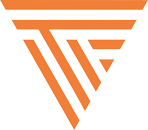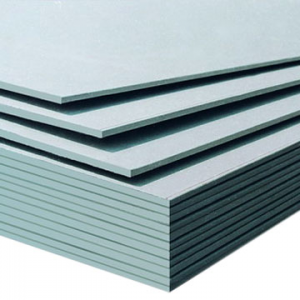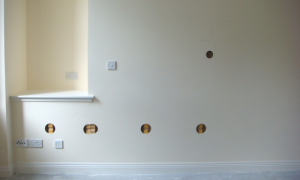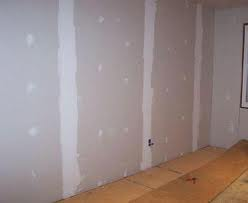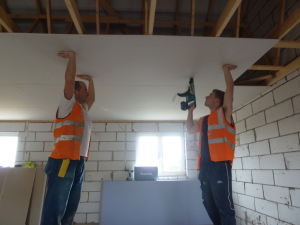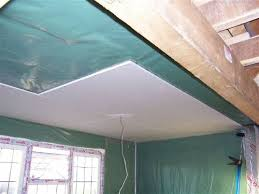WALL, PARTITION AND RECESS SYSTEMS
- Metal-framed partition - single-skinned frame construction, single-layer panel cladding
- Metal-framed partition - single-frame construction, two-layer panel cladding
- Metal-framed partition - single-frame construction, three-layer panel cladding
- Metal-framed partition - double-frame construction, two-layer panel cladding
- Installation partition - double frame construction, two-layer panel cladding
- Protective partition - single frame construction, double panel cladding + galvanised sheeting
- Protective partition - fire partition A1 single frame construction, fireboard A1, single layer panel covering
WHERE AND HOW IS PLASTERBOARD USED AND WHAT ARE ITS MAIN ADVANTAGES?
Plasterboard is a kind of “sandwich”, consisting of a core covered with cardboard on both sides. Natural gypsum is used as a filler with special additives (plasticisers and modifiers) which are needed to give the gypsum the necessary functional properties.
Plasterboard is used in the ‘dry’ method of interior decoration of buildings and structures in many areas: hospitals, airports, hotels, restaurants, banks, shops, offices, exhibition and sports halls, and in housing construction.
“The ‘dry’ method of interior finishing with plasterboard is used for smoothing wall and ceiling surfaces, creating partitions between rooms, etc.
The obvious advantage of such systems is the ease of use of the various thermal and acoustic insulation materials installed between the wall and the plasterboard.
Another advantage is the connection to the various communications – electricity, sewerage, water supply and others. All pipes, cables and wires are concealed under the plasterboard, making access to the communications completely simple.
Most importantly, these systems are lightweight, so they do not put as much strain on the slabs as a brick partition would.
This means that the frame and foundation of the house can be lightened, which significantly reduces the cost of construction. Plasterboard systems can also be used, like clay, to form a wide variety of surfaces, to create a wide variety of shapes – wavy, curved, etc. Doing something like this with bricks is very difficult and expensive, whereas with plasterboard it is much easier and cheaper.
The installation of plasterboard structures is not difficult. The main difficulty is the correct marking, and the plastering of the joints requires a suitably qualified or experienced worker.
If you need to redesign a room or change something in the interior, it is always easy to do so with plasterboard – it is not fixed “for ever”. The panels are inserted into the guide grooves and screwed to the frame, and the frame is nailed to the wall or ceiling with masonry.
Additional fixings are provided by means of strut profiles and spars. The system is highly robust and unlikely to be destroyed by mechanical action, and dismantling is quick and easy, so that any re-planning of rooms is not a problem.
